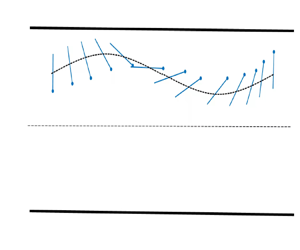Article contents
A free flexible flap in channel flow
Published online by Cambridge University Press: 25 April 2022
Abstract

Fine fibre immersed in different flows is ubiquitous. For a fibre in shear flows, most motion modes appear in the flow-gradient plane. Here the two-dimensional behaviours of an individual flexible flap in channel flows are studied. The nonlinear coupling of the fluid inertia ( $\textit {Re}$), flexibility of the flap (
$\textit {Re}$), flexibility of the flap ( $K$) and channel width (
$K$) and channel width ( $W$) is discovered. Inside a wide channel (e.g.
$W$) is discovered. Inside a wide channel (e.g.  $W=4$), as
$W=4$), as  $K$ decreases, the flap adopts rigid motion, springy motion, snake turn and complex mode in sequence. It is found that the fluid inertia tends to straighten the flap. Moreover,
$K$ decreases, the flap adopts rigid motion, springy motion, snake turn and complex mode in sequence. It is found that the fluid inertia tends to straighten the flap. Moreover,  $\textit {Re}$ significantly affects the lateral equilibrium location
$\textit {Re}$ significantly affects the lateral equilibrium location  $y_{eq}$, therefore affecting the local shear rate and the tumbling period
$y_{eq}$, therefore affecting the local shear rate and the tumbling period  $T$. For a rigid flap in a wide channel, when
$T$. For a rigid flap in a wide channel, when  $\textit {Re}$ exceeds a threshold, the flap stays inclined instead of tumbling. As
$\textit {Re}$ exceeds a threshold, the flap stays inclined instead of tumbling. As  $\textit {Re}$ further increases, the flap adopts swinging mode. In addition, there is a scaling law between
$\textit {Re}$ further increases, the flap adopts swinging mode. In addition, there is a scaling law between  $T$ and
$T$ and  $\textit {Re}$. For the effect of
$\textit {Re}$. For the effect of  $K$, through the analysis of the torque generated by surrounding fluid, we found that a smaller
$K$, through the analysis of the torque generated by surrounding fluid, we found that a smaller  $K$ slows down the tumbling of the flap even if
$K$ slows down the tumbling of the flap even if  $y_{eq}$ is comparable. As
$y_{eq}$ is comparable. As  $W$ decreases, the wall confinement effect makes the flap easier to deform and closer to the centreline. The tumbling period would increase and the swinging mode would be more common. When
$W$ decreases, the wall confinement effect makes the flap easier to deform and closer to the centreline. The tumbling period would increase and the swinging mode would be more common. When  $W$ further decreases, the flaps are constrained to stay inclined, parabolic-like or one-end bending configurations moving along with the flow. Our study may shed some light on the behaviours of a free fibre in flows.
$W$ further decreases, the flaps are constrained to stay inclined, parabolic-like or one-end bending configurations moving along with the flow. Our study may shed some light on the behaviours of a free fibre in flows.
JFM classification
- Type
- JFM Papers
- Information
- Copyright
- © The Author(s), 2022. Published by Cambridge University Press
References
REFERENCES
- 8
- Cited by



